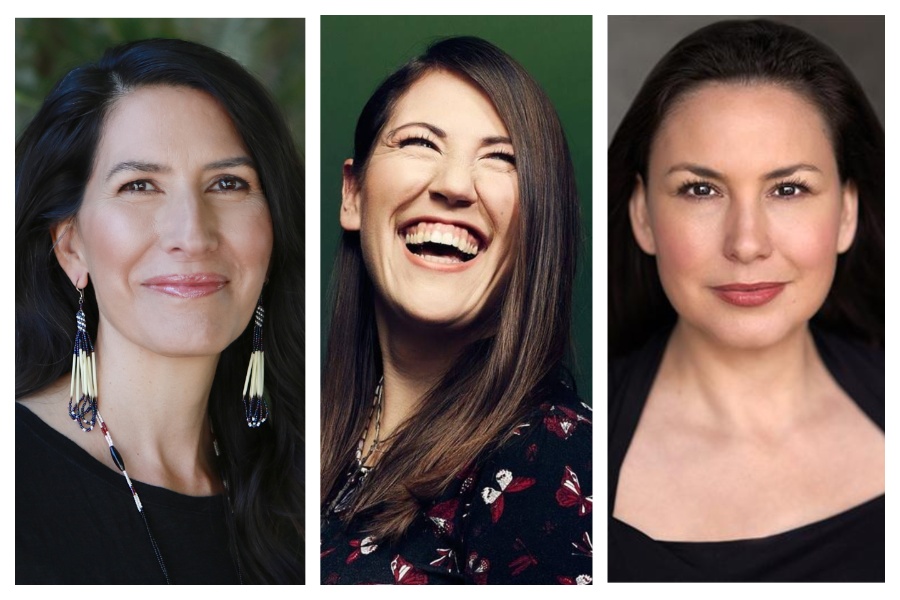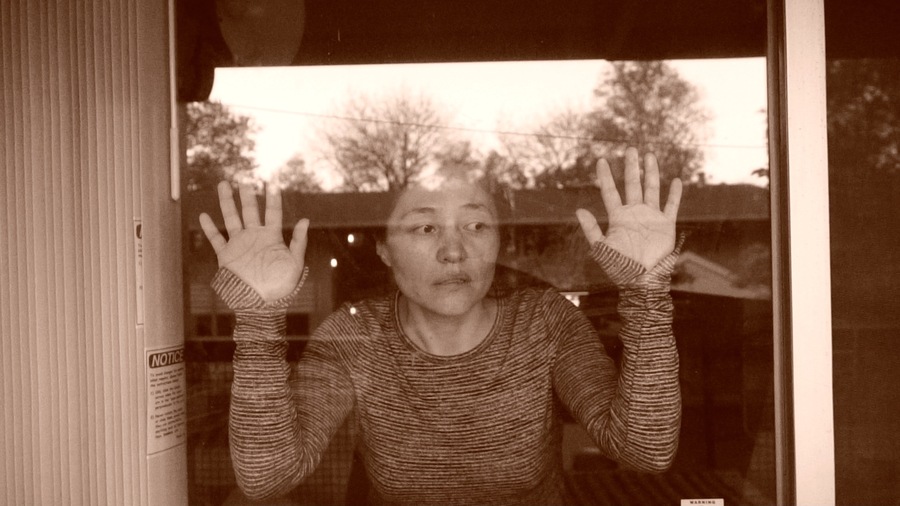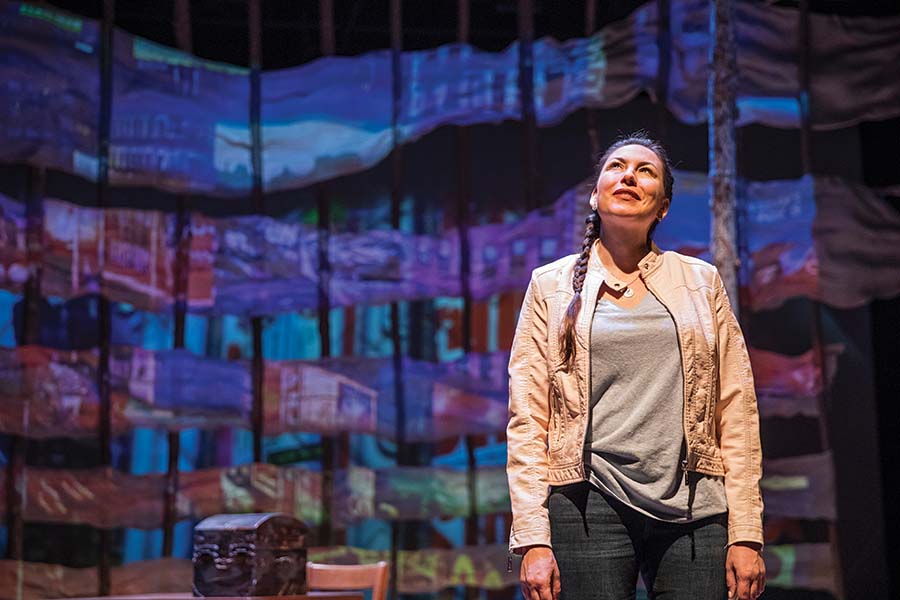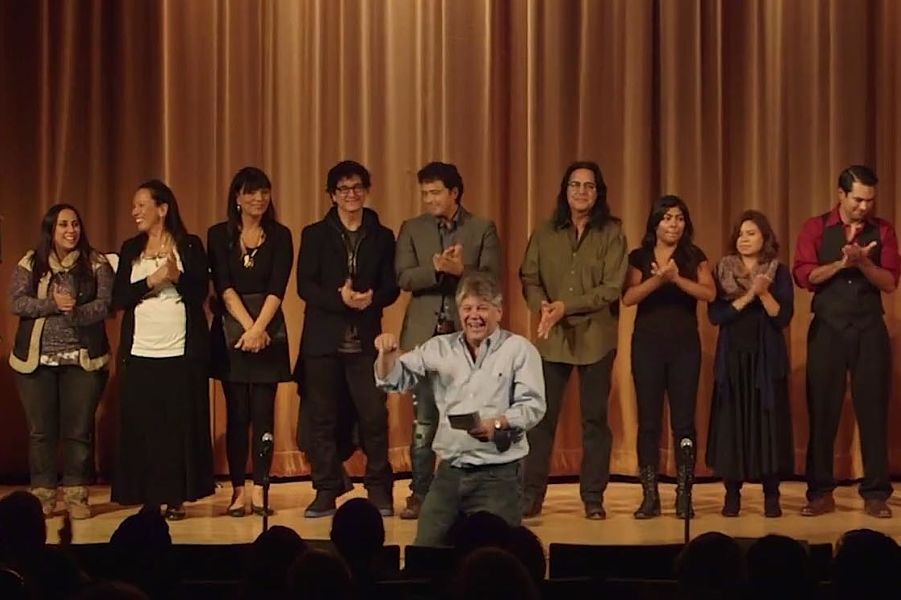The burial rites at the heart of Sophocles’s famous tragedy Antigone can seem arcane to many contemporary Western audiences. But a new adaptation at Los Angeles’s Native Voices, Beth Piatote’s Antíkoni, reimagines the play as a complicated, humanizing tragedy about a Nez Perce family living in our nation’s capital, and caught between the pressures of the outside world and a nationalist party that threatens to silence their history. Merging Nez Perce storytelling with the struggle over ancestors’ remains being held in museums, the play is being performed in one of those contested museums, in a space what was formerly the Southwest Museum of the American Indian, Nov. 8-24.
Beth (Nez Perce) joined the production’s director, Madeline Sayet (Mohegan), and Native Voices artistic director DeLanna Studi (Cherokee) in conversation recently on the relevance of Beth’s work and Antíkoni’s themes at this moment in time.
Madeline Sayet: Beth, what inspired you to write this particular adaptation of Antigone?
Beth Piatote: When I first wrote it, I wasn’t thinking about writing a play; I was writing a story that took the form of a play. I was interested in how Sophocles’ Antigone, which poses the “universal” question of what the living owe the dead, could address the problem of Native ancestral remains held in museums. The precipitating event for me was the uncovering of the remains of the Ancient One/Kennewick Man in the Columbia River in 1996, and my frustration that state institutions and anthropologists refused to listen to the Columbia River tribal communities who were immediately advocating for his return and reburial. But of course the issue of repatriation is much larger and ongoing. Artistically, the adaptation was also a chance to put two ancient story traditions in conversation, by replacing the Greek chorus with a chorus of aunties who tell Nez Perce stories from our tradition.
Madeline: DeLanna, you chose this play to be Native Voices’ 30th anniversary production. That’s a pretty big moment. Why is it significant that this production is holding that position within the company’s history?
DeLanna Studi: We had the honor of developing this play four years ago for our Festival of New Plays. I fell in love with the text and the story. I’m not a big classical Greek fan. I usually don’t like to do adaptations of old dead white guys, right? We want to make sure we are telling new stories. But something about what Beth had done made every character more three-dimensional and more human, and also it really complicated the story. I feel for a lot of our Native folks: We’re always torn between two worlds, where it’s either this or that, and we don’t see all the beautiful shades of gray. It is the 30th anniversary of Native Voices. I wanted to do something significant—something that would make a statement that would also attest to our values as Native Voices.
We are fortunate that right now we are housed under the Autry Museum. When we shared with the Autry that we wanted to do this play, they offered up one of their venues, the Southwest campus, formerly the Southwest Museum. It was founded by Charles Lummis, who did not obtain his exhibits in a legal way. There are stories that he robbed Indigenous graves, and even though he was a fan of the Native Americans, he never let any Native person tell their own story. In the venue there was a room that housed the remains of our ancestors, and unfortunately, because some of them were not identified correctly, some ancestors could not be returned home, and those ancestors are still in the Autry’s Resource Center. We knew the perfect story for this space was Beth’s play.
Another reason why Beth’s story is so profound is that it responds to the Westernized canon. We’re reclaiming not just the structure of the museum but also the re-structure of the play. This Aristotelian structure has been the epitome of what great storytelling should be. The truth is, our cultures predate that structure. What Beth has done is, she’s reclaimed this classic Greek story and has made it more complex. It’s a more human look at everything. I love the way she has constructed it: Instead of the Greek chorus, we have our collection of Nez Perce aunties that tell stories for us to learn from, and what we choose to gather from those stories will guide us or not. It’s up to us to choose. I think that’s the beauty of Native storytelling: We don’t tell you how to think. We give you options, and then you, as a sovereign individual, can choose your own path.
For our 30th anniversary, we have this beautiful play told in this beautiful museum that has been left unclaimed for the past four years. It’s an act of reclamation. I’m so grateful that Beth has entrusted Native Voices with her words so that we can share this powerful story, and I’m so grateful that you are our fearless director, Maddy, because we have been trying for four years, since I became artistic director, to get you on board in some way, shape, or form, but you are a busy woman.
My question for you, Maddy, is, what drew you to this project? What made you say yes, and what has the whole production process been like for you? We’re asking you to do the near impossible, because this is a museum, not a theatre, and we have to reconstruct this whole place within the laws of it being a historical site.
Madeline: Well, first, I am excited to finally get to work with Native Voices. It’s so nice to be in alignment with an organization on the values of a project. This play deals with issues that are important to so many of us as Native peoples. To be able to talk about issues of repatriation within a museum setting, physically, creates a visceral experience for the audience. As someone who grew up on Shakespeare, I like plays that make you work a little bit. Getting to sit around with this very brilliant cast and talk about Beth’s text is wonderful, because it’s that kind of really deep, beautiful, poetic text where there’s always another layer. So much can move and shift within a word. It’s been really exciting to see this brilliant cast of Native artists unpack what these words mean for them.
Instead of the Greek chorus, we have our collection of Nez Perce aunties that tell stories for us to learn from, and what we choose to gather from those stories will guide us or not. It’s up to us to choose.
Our show is being done in the round, which adds the sense that we are together in a circle around the story and everyone is speaking directly with you and holding you accountable. I love that we’ve been able to reclaim the space of the museum that we are performing the play in, and that the space itself has shifted with our presence. When we arrived, it was cold and hollow, but now it’s really warm and beautiful, and it’s made wonder, what would it look like if you just let the Native people have these spaces? Could they become spaces of life in a different way? We had to shift the architectural principles of the space to get it to function as a theatre—which has made me wonder about how we build different architectural spaces. Why is it normal for a museum to feel foreboding, and therefore have a 15-second reverb tail, that would never make sense in a space where people were trying to talk to each other? Why would you design a space for distance vs. togetherness? And how would you change one to the other? How do you take something that’s long and narrow and make it feel round? How do you take something that’s stone and cold and bring color to it? Why do you build one kind of space one way, and another kind of space another way—and what does that also say culturally?
Our Mohegan tribal museum is built very differently. It’s actually very homey. It wouldn’t be hard to perform, because it wasn’t built to be hierarchical and objectifying, despite being a museum.
DeLanna: It’s so exciting to be in community, because that’s what we are creating with this piece. The people behind the scenes whom you may not ever get to meet are part of our family. It is the Cherokee value of gadugi, which means the coming together of a people to celebrate, support, and promote each other. This whole process has been gadugi.
There was one conversation we had before, about the story of Creon. In the original text, Creon is a clear-cut villain. We all know going in that Creon is the bad guy and that we should root against the bad guy. Beth, what you’ve done so beautifully is that you crafted this complex, humane character torn between these two worlds. He’s this Nez Perce man living in a white man’s world, working in the white man’s way, in a governmental museum where he’s in charge of history and culture. And what’s really interesting and poignant about what you’ve written is that it takes place right before a big election—which is right when, coincidentally, what’s going on in America. Can you talk about Kreon, and what that process was like? And, of course, Maddy, the actor playing Kreon is more of a traditional person. I’d love to hear your take on that as well.
Beth: Thank you for that question. I made the choice to put all of the characters on the same side of the problem—they all feel that they are acting in the interests of their people. In Sophocles’ Antigone, it’s a freer world: Creon is the bad guy and Antigone is the virtuous one who stands up to him. There’s no colonial structure over them. What happens when you move that same plot into a colonial context is that even the person with the most power, which in this case is Kreon, is constrained by a greater power, and that structure distorts everybody’s ethical choices. In a colonial situation there are no clean ethical choices for anyone; any choice that anyone makes is going to compromise someone else or is going to create a cost for the collective. They all have their own strategies for dealing with that. Kreon has taken a common path, which is: I’m going to go up through the system, and then I’m going to change things once I have power. Antíkoni has taken another path, which is to reject the system entirely: Burn it down. We actually could not survive without both of those positions and everything in between. What you see in the play is people trying to navigate this distortion of our lives and of proper relationships.
I think Native people resonate with the complexity of the situation and recognize themselves and others in the characters. The characters become sympathetic for the ways in which they are trying to navigate this world in which, structurally, there are no clear choices. But the aunties’ stories and the drum continue to remind everyone of the proper order of the world, and that other worlds exist before and after this present time.
Madeline: I think what Beth did in shifting the plot structure from it being a “right vs. wrong” scenario to one where no one can win within the colonial system really highlights that they’re in a trap and will die in each other’s arms, over and over again, within the system designed to destroy us. Beth has also said that the traditional stories we tell within the play are the stories of the things that had to happen to make the world ready for humans, and that if we’re still capable of these kinds of deeds, we’re not yet human. Originally, I came in with my pro-Antigone, anti-Creon point of view from previous Antigones, but the more time I’ve had to listen to both characters’ arguments in Beth’s story, there really is no possible victory. In this play, Creon was able to buy back these relatives’ bodies from the black market in Europe, which gets them closer to home. He at least gets them out of some stranger’s house, where they might be displayed. But he can’t get them all the way home and buried, because he can’t use the government money for that or break the law; and because of the way they died, proper repatriation rules would separate the two brothers bodies’ again. So he thinks he’s doing what’s best, but he made that decision by himself and his community will never accept it. Morally they must be buried. But also morally, we don’t make decisions alone.
Most of America thinks Native people are stoic. We’re romanticized. We’re all-knowing. We’re one with nature. The truth is, yeah, we can be that too, but we’re also pretty darn funny.
It’s been interesting for Native actors to have think through, how would I become that separate? For white actors, to be your own person can be a logical thing to think, to be anti-community and independent. But for Native people, you have to figure out, how did you get to this place where you forgot who your community was? What kind of person is okay with cutting off an elder? I love having this all Native cast come together and be able to talk about these things.
Beth, is there any particular way you hope people listen to this story? Anything they might take away?
Beth: I want people to just come and experience the stories, and to be comfortable if they don’t understand everything at once. And I want them to be brought into our experience—the state of suspension—that we feel when our ancestors and belongings are held away from us and denied proper care. I also want people to appreciate that this adaptation is part of a very long tradition of Native people taking Western forms and inverting them or subverting them to advocate for ourselves or to try to reach these audiences.
DeLanna: Beth, that’s beautiful. What I love about your play and what I hope the audiences, especially here in Los Angeles, take away from it, is that we have a lot of museums here, many that have our ancestors’ remains, and I don’t think people realize it. I remember talking to non-Native people about the issues we were facing, and most of them were shocked when I told them what the play was about. They’re like, “Well, that would never happen.” And I have to say to them, “No, no, honey. It’s happening right now.” These are the fights that we’re fighting. For me, it’s just raising the idea that this is an issue, because if you are a non-Native person, you don’t ever have to think about this because it doesn’t impact you. We let them see behind the veil of what it’s like to be an Indigenous person living in this world, where we’re constantly code-switching and letting them understand the weight that we carry, how we have to navigate—and how sometimes we don’t do it so beautifully.
That’s what I love about this play; there is no true one way to feel about anything. We go from “I’m Team Antíkoni” to “I’m Team Kreon” to “I don’t know what team I’m on,” and it’s beautiful. I think that what is important is allowing the audience to feel how they feel. Many plays, especially in the Westernized canon, tell us how we should feel or try to persuade us to feel one way over another. The truth is, life is never, ever that simple.
Beth: That was so beautiful, DeLanna. I want to add that Antíkoni isn’t quite a tragedy. It changes shape so that many worlds are still possible at the end. Also it’s quite funny. Our actors are fantastic, and I hope that when people come they will feel free to laugh along with all the humor and warmth our actors bring to the story. It’s a reflection of Native life that is so important in this play, and Maddy has brought it out beautifully. No matter how dire something is, people are going to find a way to laugh together and connect.
DeLanna: That’s the one thing we’ve always had: our humor, right? Most of America thinks Native people are stoic. We’re romanticized. We’re all-knowing. We’re one with nature. The truth is, yeah, we can be that too, but we’re also pretty darn funny. If you let us be around our own people, and let us be ourselves, you will be quite amazed about how hilarious we can be. Sometimes there’s a line, and we cross it. And sometimes there’s a line, and it’s way back there, friends.
Madeline: Yes, the whole rehearsal process has been the fun of finding that line. Haha! Also, Beth, your play is so poetic. There are phrases that are just little gems, like, “Death is not so powerful as a story,” that can mean so many different things. People from all different cultures are just gonna wonder what that means in their own life, and carry it with them.
Support American Theatre: a just and thriving theatre ecology begins with information for all. Please join us in this mission by joining TCG, which entitles you to copies of our quarterly print magazine and helps support a long legacy of quality nonprofit arts journalism.





